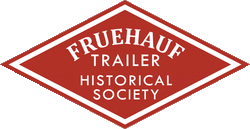- The Fruehauf Trailer Historical Society - Home
- Bookstore & Gift shop
- Classic Trailer Types
- Company History early years
- Company History - Later years
- Fruehauf Inventions and Patent List
- Military Defense Vehicles
- The Fruehauf Family
- Who Really Invented the Shipping Container?
- What Happened to the Fruehauf Trailer Company?
- The Internal Struggle for Power
- Singing Wheels and other movies
- Author's News Blog
By Roger WoodlingThis interesting refueling trailer was built for the El Paso International Airport by the Omaha Fruehauf Plant. It was used for the sole purpose of refueling the 747 transporter used to transport the space shuttle back to Florida after occasionally landing in California.
0 Comments
Contributed by Roger WoodlingAs you are aware the Omaha location of Fruehauf was not only home to the Omaha Plant, but it was the LBT Division HQ for the Omaha, Uniontown PA, Fresno CA and later Fort Wayne plants that primarily made welded products.
Another unique project assigned to Div. Engineering by Detroit was a project for United Fruit Co. The Fruehauf Div. plants had been building refrigerated 40' containers for UF to get bananas from S. America to the US for several years. United Fruit had funded research by Dr. Stanley Burg from the University of Miami to develop a longer term storage system for bananas. Dr. Burg developed a system in his refrigerator using a bell jar, vacuum pump and a hydration unit. He was able to rapidly cool the fruit, maintain a near full vacuum, provide circulation to remove gasses and maintain a specific temperature and humidity. Further experiments led to apples and other fruits, flowers and fresh meat being equally preserved. The next step was an over the highway unit to prove the system. The first unit designed by the Division Engineering Department was quickly put together with a 20' fiberglass-reinforced-plywood refrigerated container and chassis pulled out of production at the Fresno Plant and a custom-built round stainless steel tank built and assembled inside the container at the Omaha Plant. This unit preserved bananas in Miami for several months and was then loaded with fresh-cut flowers 6 weeks before Mother's Day and driven west over the mountains and delivered fresh flowers 5 weeks later in California. The next unit was a more practical 40' built from an aluminum container kit from Fruehauf R&D in Detroit and a standard 40' container chassis from one of the other plants. Omaha Plant built a square aluminum vacuum chamber. The container was assembled in Omaha around the chamber with insulation placing tubes between the two structures. The unit was then returned to Fruehauf R&D where they used their holding fixtures to support the container walls while pumping foam-in-place insulation through the withdrawal tubes between the structures. This unit had a practical payload and was used for numerous trials. Unfortunately, even though the concept worked well, it was not economical for bananas, so UF pulled the plug on the project. Several years later a shipping company commissioned an East-Coast manufacturer to build 125 40' containers with the same system to ship fresh US beef to the Mid-East where cost was not a concern. I'm not aware of and further use of the concept. I always expected to see such a compartment in our home refrigerators. Yellow Freight lives on in this beautiful restoration of a Mack truck and a Fruehauf Trailer5/20/2017  1939 Mack BM and 1937 Fruehauf Trailer In the collection of The Keystone Museum The Keystone museum and Keith Jones, acquired this restored truck and trailer from the Overland, Kansas headquarters, when YRC was renovating their offices. An exterior wall needed to be removed to permit the trailers to be moved. In 1929, A.J. Harrell determined that the color of the Swamp Holly Orange would be most visible from the greatest distance. Swamp Holly Orange became the color used on all company tractors. In 1906, Grover Cleveland “Cleve” Harrell (1884-1942) started what was to become the Yellow Cab Company with a horse-drawn hack and a team of horses in Oklahoma City. After a year, he bought a Model T Ford. In 1918, Harrell painted one of his cars yellow. Although ridiculed by other cab drivers, he was hauling more passengers than anyone else, so he painted all his cars yellow and business boomed. Harrell trademarked the name Yellow Cab in Oklahoma. Later, John Hertz copied the Yellow Cab in Chicago and obtained the national trademark for the use of the name. When oil was discovered in the Oklahoma City area, mules were needed for work in digging slush pits, so the Harrell brothers bought mules and, in 1929, established the Yellow Transit Freight Lines to serve small manufacturers for whom freight was slow and express rates were prohibitive. About this time, the Harrell brothers dissolved the partnership. A.J. took control of the freight lines, which he operated for many years. The company remained small until 1952, when an ownership group led by George E. Powell Sr. bought the freight company. During this time, Yellow helped pioneer the concept of consolidating small freight shipments into trailer loads, an idea pioneered by the Fruehauf Trailer Company. Fruehauf’s age old sales pitch involved companies using, what Fruehauf called, “the shuttle system.” They calculated great cost savings to trailer customers when multiple trailers were employed in haulage simultaneously. In December 2003 Yellow Corp. acquired Roadway Corp. for $1.05 billion, forming Yellow Roadway Corporation or YRC. This newly restored 1958 Fruehauf Featherweight 4 compartment tank & "Miss Heather Lee" a 1958 B61 Mack is in the collection of Rymes Propane & Oil, Jim and Heather Rymes
The truck is a 1958 B61, with a 673 engine and 10 speed duplex transmission. The trailer, a classic Fruehauf "Featherweight" was engineered in the 50s, known for their aerodynamic, streamlined lines. This tanker was originally owned by Rosario Bernier Oil, in Greenville NH to service urban fuel deliveries. They used it for 20 years and then parked it until 2000 when it had a complete frame off restoration. In 2013, Recognizing a familiar site, Jim noticed the trailer on the back of a truck on its way to the local scrap metal dealer. Jim turned around and literally chased the owner into the scrap yard. He bought it on the spot! 10 minutes later it would have been shredded. They hired L. W. Welding in Uxbridge, Mass, to restore and repair it, including brakes, all skirting, all new toolboxes, the fifth wheel support area, new rear bumper and ladder. They got it to the point of being in primer. Then it was returned to the Rhymes’ Hudson, NH shop and a crew wired it, ran airlines and completed all the remaining work. Jim’s family was his primary crew. His wife, Heather and daughters, Colby, Bailey, and Mackenzie, rooted on by Jim’s brothers, John and Tom. The family was creating a tribute to Jim’s parents, Jim Sr and his wife Carol who had started the family company with a similar Fruehauf Trailer. Jim Sr. and Carol Rymes started their business with nothing in the 1950s . Their original Fruehauf, acquired from the Waltham, Mass Fruehauf branch, was a double conical 10,500-gallon that ran day and night to pay the bills. It never let him down and was a big investment for the time. He was able to reduce his deliveries to four trips instead of five, using the more efficient Fruehauf. At the end of the year, it really increased the gallons hauled and lowered costs as well. The final touches were the paint and the signage. The family selected Mack red to match the tractor, using primer not bonds, to smooth things out. Walt from Walts signs, in Jaffrey, NH, hand pinstriped and lettered it. As a side note, he had lettered the tractor for Bernier in the 60's. And the Mack was named after Jim’s beautiful Heather Lee. He used to love seeing all the nicely lettered trucks named after ladies, when he was a kid, riding with his Dad. A great American story of hard work and perseverance, today, the Rymes brothers, Jim, John and Tom employee 300 dedicated people in their business, which was begun by their dad. Heavy Duty Trucking's Tom Berg contributes this story:www.truckinginfo.com/blog/trailer-talk/story/2017/05/how-fruehaufs-and-whites-once-hauled-unique-steel-houses.aspx
Ever hear of Lustron houses? They are prefabricated, porcelain-painted steel structures that were produced from 1947 to 1950 in a factory in Columbus, Ohio, and carried by the builder’s private truck fleet to erection sites in every state east of the Rockies. I had forgotten about these uniquely designed houses until I saw an exhibit on “1950s life” at the Ohio Historical Center. It includes a complete Lustron model home because it was a local product. Read More....... Dayton Wheels & Early Fruehauf wheel |
The advancement of transportation accelerated the economic growth of all industries in the industrial booming United States. The Fruehauf Trailer Company contributed to the advancement of American industry.AuthorsRuth Ann Fruehauf and Darlene Norman have dedicated hard work, determination and intuition to bringing this project to life. This is the ongoing investigation and reporting of their efforts.
Click on the names above for biographical information on our authors. Archives
January 2018
Categories |
PLEASE CLICK ON TITLES WHICH ARE HYPERLINKED TO OTHER TOPICS
Home - Company History-EARLY - COMPANY HISTORY - LATER - CLASSIC TRAILERS - THE 5TH WHEEL - - MARTIN
ROCKING - FRUEHAUF INVENTIONS - MILITARY - SHIPPING CONTAINER - MALCOLM MCLEAN - What Really
Happened - Internal struggle for Power - FRUEHAUF IN THE MOVIES - TRAILER PHOTOS - VIEWERS
CONTRIBUTE - News Blog - FRUEHAUF FAMILY - Killarney - Fruehauf airplanes - GLOBAL OPERATIONS STILL
ACTIVE - WHO INVENTED THE MUDFLAP -PRESS FOR SINGING WHEELS - MUSEUM EXHIBITION - Store
We are SocialAn organization dedicated to the preservation of the history of Fruehauf Trailer Company and the Fruehauf family legacy.
The society has created historical books and a traveling exhibit rich with Fruehauf memorabilia and archival materials. Our next book, “Fruehauf, the First Name in Transportation” an in-depth analysis of the company’s history will be published soon. |
Copyright © 2013 -20 by
Ruth A. Fruehauf and Darlene Norman. All rights reserved. |
- The Fruehauf Trailer Historical Society - Home
- Bookstore & Gift shop
- Classic Trailer Types
- Company History early years
- Company History - Later years
- Fruehauf Inventions and Patent List
- Military Defense Vehicles
- The Fruehauf Family
- Who Really Invented the Shipping Container?
- What Happened to the Fruehauf Trailer Company?
- The Internal Struggle for Power
- Singing Wheels and other movies
- Author's News Blog










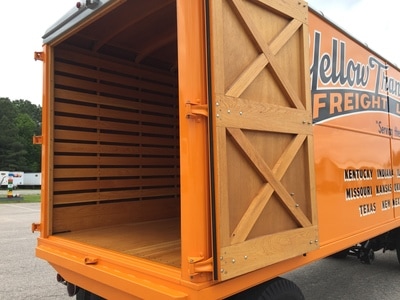



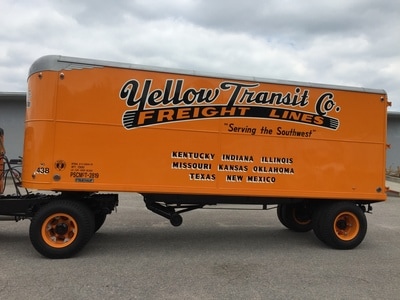
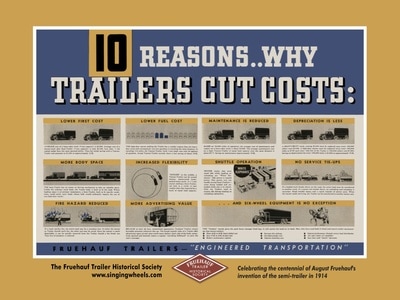

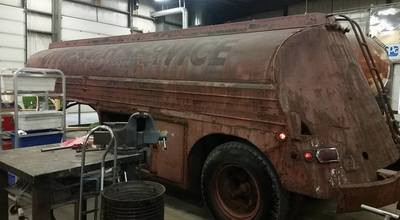
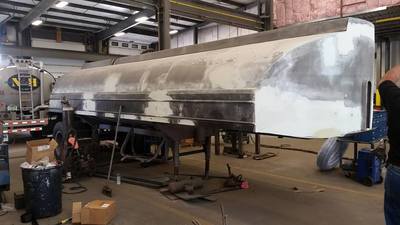


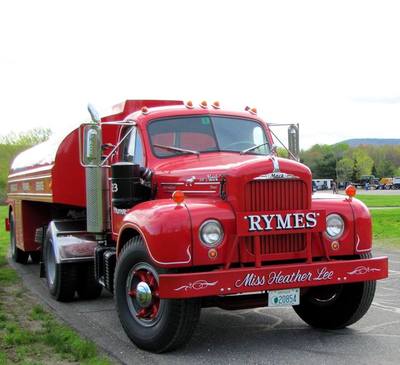


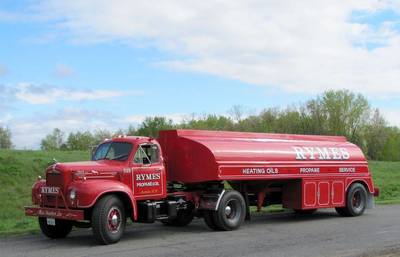


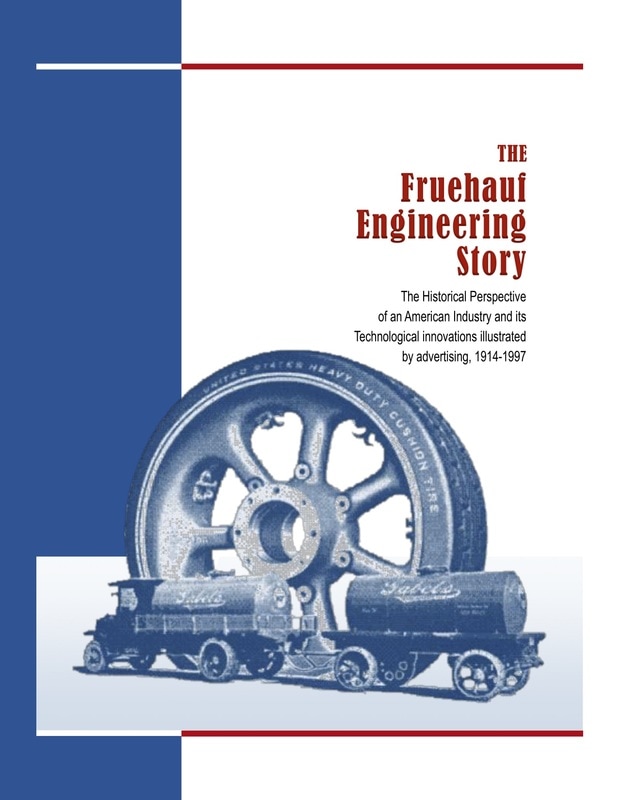


 RSS Feed
RSS Feed
